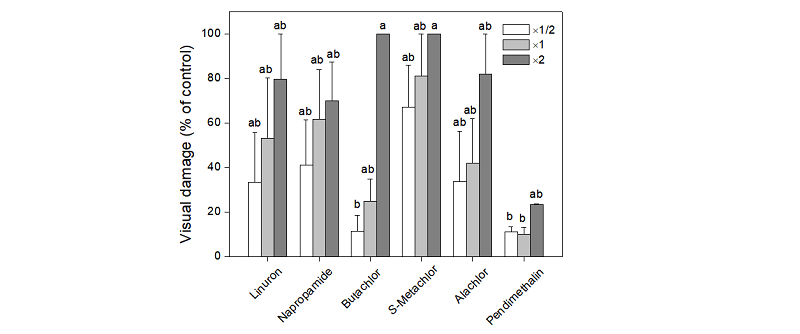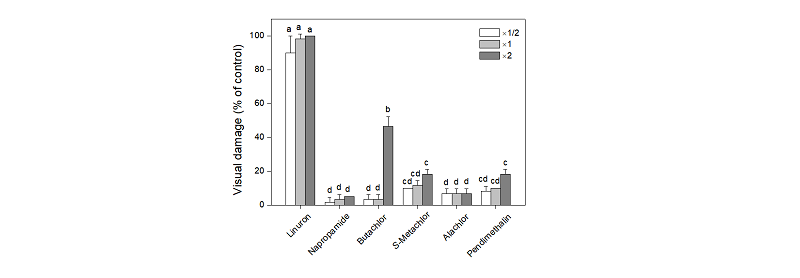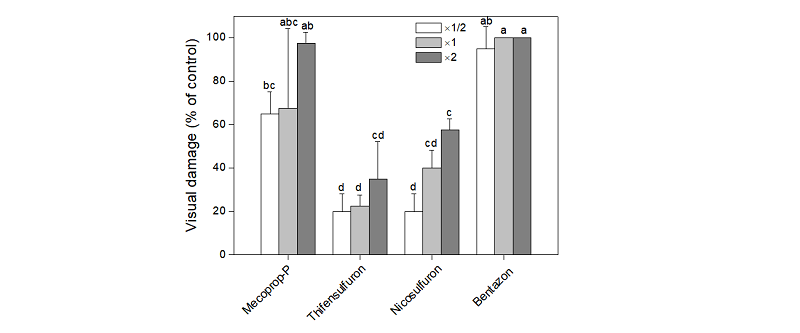Introduction
생활소득의 증대와 주 5일제 근무 도입 등 국민들의 삶의 질이 개선되면서 그 어느 때보다 기능성 식품과 건강에 대한 관심이 높아지고 있으며 농산물수입 개방과 국내농업 경쟁력 악화에따른 새 소득작물의 개발과 안정적인 소득마련을 위해 약용작물이 고부가가치 작물로서 새롭게 주목 받고 있다. 우 리나라에는 당귀(Angelica gigas), 천궁(Cnidium officinale) 등 60 여 종의 약용작물이 재배되고 있으며, 황금(Scutellaria baicalensis G.)은 꿀풀과에 속하는 다년생 초본식물로서 황금의 뿌리는 소염, 해열, 구토, 복통, 설사 등에 효능이 있어 한약재로 널리 사용되어 왔다(Lee and Chae, 2007). 황금의 뿌리에는 플라보노이드 성분인 baicalein, baicalin, wogonin, wogonoside 등이 있어 황산화 효과가 있으며(Gao et al., 1999; Gao et al., 2001), 최근 연구에 따르면 이들 성분은 항박테리아(Zhou et al., 2009), 항진균(Yang et al., 1995)과 같이 미생물 억제 작용과 항염증(Kim et al., 2009), 진통억제(Lee et al., 2007), 항암 효과(Zhang et al., 2003), 신경보호 기능(Mu et al., 2009) 등 약리 작용을 가지고 있다.
황금의 뛰어난 효능에도 불구하고 국내에서 생산은 미미한 수준이며 생산량은 1998년 383톤에서 2016년 18톤까지 지속적으로 감소하였고 2017년에는 생산액을 책정할 수 없는 실정이다(MAFRA, 2018). 국내 황금 재배는 주 생산지인 전라남도 여천군을 중심으로 노지 직파재배가 관행적으로 이루어지고 있으며(Kwon and Kim, 1996), 전남 농업기술원과 전남지역 대학에서 황금의 생육과 수량 및 품질 향상을 위하여 파종 밀도(Kwon et al., 2002), 파종기(Kwon and Park, 1997), 적심시기(Kim et al., 1998a), 시비법(Kim et al., 2001), 피복재배(Park et al., 1995) 등 재배법 개선을 위한 연구와 황금 재배를 위한 맥후작 작부체계 연구가 주로 수행되었다(Kwon and Shin, 2001). 하지만 직파재배에서 사용할 수 있는 제초제 선발이 그 동안 이루어지지 않아 인력제초가 많이 행해졌고 여전히 제초작업이 효율적으로 이루어지지 못하고 있다. 점차적으로 재배농가가 노령화되고 그 수가 감소되는 상황에서 재배농가의 고충이 예상되며 황금의 재배생산을 확대하기 위해서는 무엇보다도 황금에 안전한 제초제 선발이 시급한 실정이다.
본 연구는 황금 경작지에서 안전하게 사용할 수 있는 제초제를 선발하여 효율적인 잡초방제가 이루어질 수 있게 잡초방제체계의 기초자료로 활용하고자 수행하였다
재료 및 방법
경기도 수원시 서울대학교 농업생명과학대학 부속 실험농장 내 온실에서 황금 종자를 파종한 포트를 난괴법 4반복으로 배치하여 2010년 4월부터 황금에 대한 토양처리 및 경엽처리 제초제의 선발 실험을 수행하였다.
토양처리용 제초제의 약해 실험
약용작물을 비롯한 타 작물에서 등록된 토양처리용 제초제 6종(linuron, napropamide, butachlor, S-metolachlor, alachlor, pendimethalin)을 황금 출아 전 및 5-6엽기에 1/2배량, 기준량, 2배량을 8002E flat fan nozzle이 장착된 belt-driven sprayer (R&D Sprayer, USA)를 이용하여 살포량 600 L ha-1로 토양 표면 또는 경엽에 처리하였다(Table 1). 약제처리 후 30일 차에 달관조사하여 약해를 평가하였다.
경엽처리용 제초제의 약해 실험
약용작물을 비롯한 타 작물에서 등록된 경엽처리 약제 4종(nicosulfuron, mecoprop-p, bentazone, thifensulfuron-methyl)을 황금 5-6엽기에 1/2배량, 기준량, 2배량을 8002E flat fan nozzle이 장착된 belt-driven sprayer를 이용하여 살포량 600 L ha-1로 경엽에 처리하였다(Table 1). 또한 경엽처리 제초제 4종(2,4-D, triclopyr-TEA, carfentrazone-ethyl, fluroxypyr-meptyl)을 추가하여 총 8종의 제초제를 황금 11-12엽기에 기준량, 2배량으로 5-6엽기에 처리한 바와 같이 동일한 방법으로 경엽에 처리하였다. 약제처리 후 30일 차에 달관조사하여 약해를 평가하였다.
통계분석
황금의 약해는 분산분석(ANOVA) 및 Tukey의 HSD (Honestly significant difference) 검정을 통해 유의적 차이 여부를 평가하였다. 모든 통계분석은 R 프로그램(version 3.4.3, R core Team, 2018)의 agricolae 패키지를 이용하여 수행되었다.
결과 및 고찰
토양처리용 제초제의 약해 안전성
6종의 토양처리 제초제를 황금 출아 전에 처리한 후 30일차에 황금의 약해를 조사한 결과, linuron, napropamide, S-metolachlor, alachlor의 처리는 1/2배량에서도 30% 이상의 생육저해와 변색을 동반한 출아억제가 발생하였으며, butachlor는 기준량 처리에서 20% 이상의 약해가 발생하였다(Fig. 1). 반면에 pendimethalin의 처리는 기준량에서는 10% 미만의 경미한 생육저해를 보였으나 추후 회복되었고, 2배량에서는 약 20% 정도의 경미한 약해가 발생하여 실험 제초제 가운데 낮은 약해를 보였다. 따라서, 약제 6종을 황금 출아 전에 처리한 경우 pendimethalin을 제외한 5종의 제초제는 황금에 대한 약해가 심하여 사용하기 어려울 것으로 판단되며, pendimethalin은 약간의 출아억제가 있었으나 그 정도가 크지 않아 사용이 가능할 것으로 판단되었다.

Fig. 1.Visual damage of pre-emergence (PRE) herbicides on Scutellaria baicalensis applied immediately after sowing under pot conditions. The visual damage (%) was assessed 30 days after application. The vertical bars represent the standard error of the mean of four replicates. a, b: Means with same letter are not significantly different by Tukey’s test at P=0.05.
황금이 출아한 이후 잡초발생을 억제하기 위하여 사용이 가능한 토양처리제를 선발하기 위해 동일한 토양처리 제초제 6종을 황금 5-6엽기에 처리한 후 30일차에 황금의 약해를 조사하였다. 그 결과 linuron의 처리는 높은 약해를 유발하였으며, butachlor의 경우 기준량 처리는 약해발생이 크지 않았으나 2배량 처리에서 50%에 달하는 약해가 발생하였으며,나머지 제초제들은 2배량에서도 20% 미만의 약해가 발생하여 이후 생육에서 회복 가능하여 안전한 것으로 판단되었다(Fig. 2). Klett et al. (2008)은 황금과 같은 속 식물인 Scutellaria resinosa의 생육 초중기에 잡초의 발생을 억제할 목적으로 pendimethalin을 처리한 결과 약해가 거의 없음을 보고하였는데, 이는 본 연구의 결과와도 유사하였다. 결과적으로 황금의 출아 전후로 잡초의 발생억제용 제초제로는 시험 약제 중 pendimethalin 만이 약해가 적어 사용이 가능할 것으로 판단되며, 황금이 출아한 이후에는 alachlor와 napropamide 등의 사용도 가능할 것으로 보여진다.

Fig. 2.Visual damage of pre-emergence (PRE) herbicides on Scutellaria baicalensis applied at its 5-6 leaf stages. The visual damage (%) was assessed 30 days after application. The vertical bars represent the standard error of the mean of four replicates. a-d: Means with same letter are not significantly different by Tukey’s test at P=0.05.
경엽처리용 제초제의 약해 안전성
4종의 경엽처리 제초제를 황금 5-6엽기에 처리한 후 30일차에 황금의 약해를 조사한 결과, mecoprop-p와 bentazon은 기준량에서 60% 이상의 생육저해와 변색을 동반한 약해가 발생하였으며, nicosulfuron과 thifensulfuron도 2배량에서 30% 이상의 약해가 발생하였다(Fig. 3). 따라서 황금 5-6엽기는 이들 경엽처리 제초제에 여전히 민감한 시기로 판단되며, 새로운 시기와 보다 다양한 제초제의 평가가 필요하였다. 이에 따라 새로운 제초제를 추가하고 제초제 처리시기를 보다 늦추어 황금에 보다 적합한 경엽처리용 제초제 평가를 추가 실시하였다. 앞서 사용된 4종의 약제 외에 2,4-D, triclopyr-TEA, fluroxypyr-meptyl, carfentrazone-ethyl을 추가하여 총 8종의 약제를 황금 11-12엽기에 처리한 후 30일차에 황금의 약해를 조사한 결과, 전체적인 약해는 황금 5-6엽기에서 보다 감소하였으나, 2,4-D, triclopyr-TEA, fluroxypyr-meptyl, mecoprop-p, carfentrazone-ethyl, bentazon은 2배량 처리에서 40% 이상의 약해가 발생하여 황금 11-12엽기에도 경엽처리용으로 사용하기 어려울 것으로 판단되었다(Fig. 4). 그러나 nicosulfuron과 thifensulfuron은 각각 6%와 15%로 황금 5-6엽기에서 발생한 약해보다 현저히 낮아 사용 가능성을 확인하였다(Fig. 4). 다만, Du et al. (2012)의 연구에서 nicosulfuron은 온실조건과 다르게 포장조건에서 황금의 약해가 심하게 나타나 사용에 주의가 필요하다고 하였다. 결과적으로 황금의 생육 중기에 잡초의 생육억제용 약제로 nicosulfuron과 thifensulfuron의 사용이 고려될 수 있지만, 보다 안전한 사용을 위해서는 다양한 재배환경에서의 추가적인 검토가 필요하다.

Fig. 3.Visual damage of post-emergence (POST) herbicides on Scutellaria baicalensis applied at its 5-6 leaf stages. The visual damage (%) was assessed 30 days after application. The vertical bars represent the standard error of the mean of four replicates. a-d: Means with same letter are not significantly different by Tukey’s test at P=0.05.
황금재배에 적합한 토양 및 경엽처리 제초제의 체계처리에 의한 잡초방제
본 연구를 통해 선발된 토양 및 경엽처리 제초제는 황금 재배지의 효율적인 잡초방제를 위하여 재배시기를 고려한 체계처리용 약제로 사용될 수 있을 것으로 판단된다. 토양처리용 제초제로서 pendimethalin은 Klett et al. (2008)의 연구에서 대표적인 화본과잡초인 피속류(Echinochloa spp.)와 강아지풀속류(Setaria spp.) 잡초의 발생을 효과적으로 억제한 바 있어, 황금의 출아 전후로 화본과 문제잡초의 발생을 억제할 목적으로 사용할 수 있을 것으로 판단된다. 기존에 타 작물에서 pendimethalin 뿐만 아니라, napropamide, alachlor, S-metolachlor은 일년생 화본과잡초 및 일부 광엽잡초(쇠비름[Portulaca oleracea], 개비름[Amaranthus lividus], 명아주[Chenopodium album])의 발생억제에 효과적이기에 황금 생육 초중기(5-6엽기)에 사용될 수 있을 것이라 판단된다(Kim et al., 1998b; Song et al., 2016). 황금 생육 중기(11-12엽기)에 잡초의 생육을 억제하기 위해서 nicosulfuron과 thifensulfuron의 경엽처리가 고려될 수 있으며, nicosulfuron과 thifensulfuron은 피, 강아지풀 등의 화본과잡초와 명아주, 개비름, 독말풀(Datura stramonium), 어저귀(Abutilon avicennae) 등의 광엽잡초를 선택적으로 방제하는데 유용할 것으로 판단된다(Dobbels and Kapusta, 1993; Knežević et al., 2003). 따라서, 본 연구에서 선발된 pendimethalin을 포함한 토양처리제와 경엽처리제로서 nicosulfuron과 thifensulfuron을 황금 재배지에서 재배시기에 맞추어 체계 처리하는 것이 효율적인 잡초관리에 있어 유리할 것으로 판단되며, 추가적인 체계처리에 대한 다양한 재배 환경에서의 포장평가 등이 필요할 것으로 사료된다.

Fig. 4.Visual damage of post-emergence (POST) herbicides on Scutellaria baicalensis applied at its 11-12 leaf stages. The visual damage (%) was assessed 30 days after application. The vertical bars represent the standard error of the mean of four replicates. a-f: Means with same letter are not significantly different by Tukey’s test at P=0.05.



